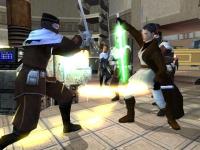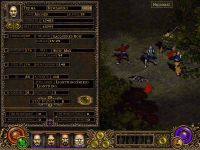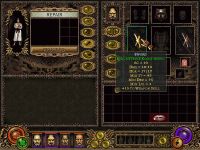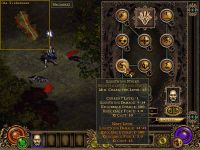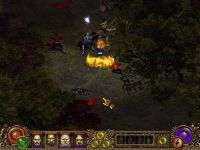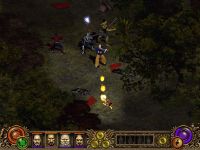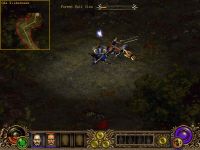|
|
|
Main News Forums Games Games Database Top 100 Release List Support Files Features Reviews Previews Interviews Editorials Diaries Misc Download Gallery Music Screenshots Videos Miscellaneous Staff Members Privacy Statement |
Throne of Darkness Review Stiletto, 2001-11-05
The World of Throne of Darkness The accuracy of Throne of Darkness, while great, is confusing a lot of the times. There are many different types of weapons in the game, and with actual Japanese names, takes a long time to actually understand and remember the usefulness of each one.
The Beginning You start off in the shrine room of your Daimyo's (lord's) castle, with three of the possible seven samurai you can use. The Daimyo requests that you rid the castle of the invading General, which is easier said than done. Once you leave the room, you face dozens of undead, armed with swords, hammers, bows and magic. As you defeat them, you get experience points, gold, and the four other samurai to add to your group. But while you're doing all the dirty work, your Daimyo aids you in your journey, with a completely unique feature. If ever one or more of your samurai get badly wounded, run out of ki (mana), or even die, you can teleport them back to the original shrine room, where their health raises automatically. You will use this feature a lot in your travels, as it would be nearly impossible to even get past the introductory levels without it. Health potions are rare, and when you're being attacked full force, it is much easier to teleport your samurai in and out, instead of clicking on each of them and making them heal individually. Need some assistance?
The first of the two you meet, the Blacksmith, is the master of metal. Each weapon and piece of armour has a Durability rating, and if that falls to zero, you won't be able to use it until it gets repaired, and that's where the Blacksmith comes in. For a small fee (and an amount of time depending on the quality), the Blacksmith will make it good as new. A new ( but not necessarily better) feature introduced in Throne of Darkness, is that you can't sell the excess equipment you pick up, but you can give them to the Blacksmith, which then get turned into a rating. The more you give him in the three categories: melee, ranged and armour; the bigger and better pieces he can make for them, which after a while, could end up being super weapons. The Priest will probably be the least used of both the supporting characters. He identifies items, allows you to give items to the gods (which gives you spell points to spend in your spell tree), turning cursed items normal, and buy potions. The Priest is a good idea, but his wares cost too much for any beginning party to take advantage of, and by the later levels its unlikely he would be needed too much. Gaining Experience The experience point system is slightly different from other games. You get experience for hitting the enemy, as well as killing them. The points add up, and you get levels, where you can raise your statistics by a set number of points, as well as one point for each of your spell trees. The statistics in the game are standard Role Playing Game fare, and include Strength, Dexterity, Vitality, Ki, and Charisma. Strength affects how hard you hit; Dexterity affects how well you can handle weapons; Vitality raises your hit points; Ki raises your mana; and finally, Charisma gets you discounts when you spend money. A Little Bit of Magic Unless you're controlling a samurai and personally casting a spell, you will rarely ever see your samurai do it. And when they do, it doesn't quite make sense; I've seen my Berserker cast much more than my Wizard, which is quite confusing. In a way, that doesn't particularly matter though, most spells barely dent monsters, and as you get higher level spells, the enemy get much stronger as well, so it evens out again. Anyone that has played Diablo 2 will instantly recognize and be comfortable with its spell-tree. Each element has 4 tiers of spells, and as you gain levels and more spells open up to you, the ones directly below, which are more powerful versions of their former ones, can be picked.
About Gold and Waypoints The waypoint system was made with the same basics as found in D2, but even this has its short comings. You originally get waypoints added to your list when you step on them, but they don't come in any particular order, so if you ever need to go to a certain place, unless you have a great memory you won't get it on the first try. Not only that, but you won't even use the waypoints all that much, apart from in a multiplayer game, and when finished in an out of the way place.
Graphics and Music The sounds and music in the game aren't great, but they aren't horrible either. When engaged in fights, you'll hear a lot of grunts and screams from both sides, and the swinging and connecting of weapons to the enemy. That has to be the only time you will hear a sound, when running around there is no sound. The music is very low, but moody, setting the atmosphere quite well, but unfortunately there isn't much of a variety in the game. The Verdict Sound: 6.0 (20%) Control: 8.5 (25%) Fun: 7.5 (25%) Over-all: 7.1 Throne of Darkness is a game hidden behind minor design flaws and slight graphical inferiority. The game itself is very playable and extremely stable (a rarity in games nowadays), but little annoyances get in the way. The music and graphics won't impress you, but the gameplay should, even with the problems. You will come back to play the game, it might take a few minutes, or it might take days. So if you don't mind a game with many similarities, but not quite as good, to Diablo 2, this could very well be your game.
Average Reader Ratings: 6.64 (14 votes) |
|||||||||
|
All original content of this site is copyrighted by RPGWatch. Copying or reproducing of any part of this site is strictly prohibited. Taking anything from this site without authorisation will be considered stealing and we'll be forced to visit you and jump on your legs until you give it back. |
||




